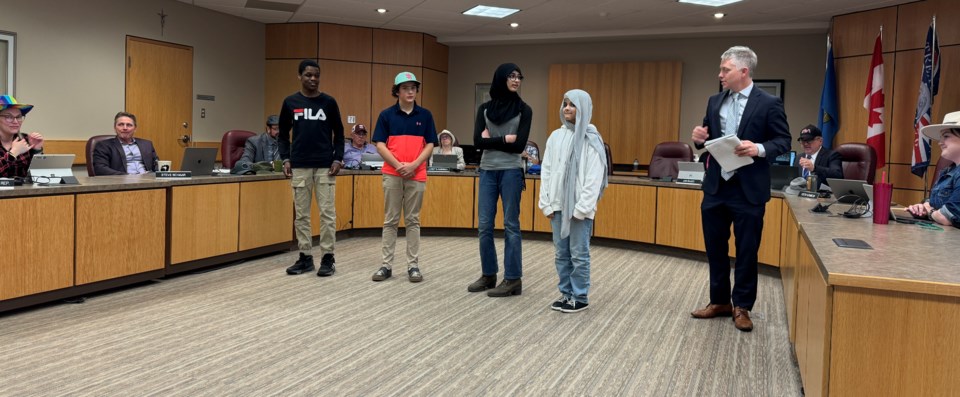ST. PAUL – During the regular St. Paul Education board meeting on May 9, four students who will be competing in the national youth science fair in Ottawa presented their projects to trustees.
Presenting first was Fatima Abbasi, with her “Fire Fusion: the Future of Fire Detectors” project. For her project, she worked on a detector that could more “efficiently” detect fires, she told the board.
The inspiration came from her own experiences at home, when a smoke detector goes off in a false alarm, for example when someone is just cooking.
“I wanted to fix this with a much more cost-effective solution that is much more accurate,” she explained.
She created a prototype through sensor fusion, using multiple sensors in a single device, which go off only when certain conditions are met. Her detector senses the temperature, smoke, motion, and even if there is flame in a room or an environment.
When motion is sensed, the detector checks the temperature and humidity. If the temperature is high, the detector turns on the smoke and flame sensors. When smoke is detected, a built-in camera snaps a photo and analyzes it. If there is fire, it notifies the homeowner through a text message.
She tested the viability of her prototype through an incense stick and found that a traditional type of smoke detector goes off, while her prototype did not – avoiding a false alarm.
Augmented Reality for impaired hearing
Abdul Qudoos Abdulsalam, who worked on using augmented reality for those with impaired hearing, also presented to the board. He created an app using Unity and Xcode that displayed what a user would be hearing in an environment.
The app works in a way that transcribes what is happening in the environment of a user.
“I wanted people in situations like these to still have access to communication and collaboration with others, and to help make the world more inclusive and connected,” he says.
Abdulsalam says his application also has a real-time translation function that breaks the language barrier.
Germinating seed in space
For Abeera Abbasi, her project answers the question, “can plants from Earth grow in space?” Her “AstroFlora: Engineering Plant Growth for Space Exploration” project is about germinating basil seeds in space conditions.
To mimic the conditions, she had to simulate microgravity and space radiation. For microgravity, she designed a clinostat that rotated less than three rotations per minute.
She then planted seeds on a petri-dish positioned on the clinostat. For the simulation of space radiation, she used a UVB radiation lamp.
Abeera found that not only can plants germinate, but they also grow faster in microgravity. But those benefits are reduced with radiation. Thus, she concluded the importance of managing factors like light exposure.
“Future research should focus on optimal conditions to maximize the benefits of microgravity and ensure successful cultivation in space,” said Abeera.
Vaping in youth
Ryan Noel worked on the “Vaping in Youth” project. He wanted to raise awareness on vaping and its harmful effects, after noticing an increase in students vaping.
His research found that five per cent of youth aged 12-14 admitted to vaping, while 21 per cent of youth aged 15-17 admitted they tried vaping.
He created a 10-minute presentation outlining the dangers of vaping and included a survey at the bottom, asking if students learned anything new from the presentation, or if the information provided encouraged a student not to vape.
The presentation and survey were sent out to four local schools to complete and view.
Of 366 respondents, 75.3 per cent said they learned new information, whereas the rest stated they did not; 91.1 per cent said the information encouraged them not to vape; and 78.9 per cent agrees more information needs to be provided to youths to prevent vaping.
Noel acknowledges that the data he collected may be skewed in a limited manner due to “trolling”. But that suspicion only applies to about nine respondents who all responded “No” on the survey.
Noel concludes that more awareness in vaping is required and asked to work with the board of trustees in finding ways to accomplish that. “It is my goal to help multiple kids refrain from trying vaping in the future, so join with me and we can make a change.”
The board indicated that they were susceptible to the idea. They then thanked all the student delegates for their presentations and bid them the best in their journey to the national science fair.
The students will fly to Ottawa for the Canada-Wide Science Fair (CWSF), hosted by Youth Science Canada from May 26 to 31.



